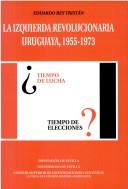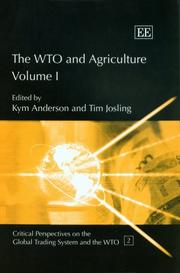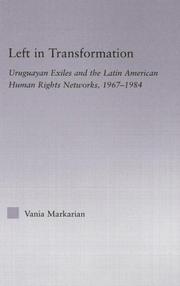| Listing 1 - 10 of 16 | << page >> |
Sort by
|
Book
Abstract | Keywords | Export | Availability | Bookmark
 Loading...
Loading...Choose an application
- Reference Manager
- EndNote
- RefWorks (Direct export to RefWorks)
Book
ISBN: 3906166252 Year: 2005 Publisher: Ruggell A.R.G. Gantner Verlag
Abstract | Keywords | Export | Availability | Bookmark
 Loading...
Loading...Choose an application
- Reference Manager
- EndNote
- RefWorks (Direct export to RefWorks)
Algae --- Uruguay --- microphotographs --- Bacillariophyta = Diatoms = Diatomeae

ISBN: 8447208257 8400083091 8477982082 9788400083090 9788447208258 9788477982081 Year: 2005 Volume: 96 17 435 Publisher: Madrid: CSIC,
Abstract | Keywords | Export | Availability | Bookmark
 Loading...
Loading...Choose an application
- Reference Manager
- EndNote
- RefWorks (Direct export to RefWorks)
History of Latin America --- anno 1970-1979 --- anno 1960-1969 --- anno 1950-1959 --- Uruguay --- Left-wing extremists --- Government, Resistance to --- Extrémistes de gauche --- Résistance au gouvernement --- Politics and government --- Politique et gouvernement --- History --- Extrémistes de gauche --- Résistance au gouvernement --- Left-wing extremists - Uruguay. --- Government, Resistance to - Uruguay - History - 20th century. --- Uruguay - Politics and government - 1904-1973.

ISBN: 184376279X 9781843762799 Year: 2005 Volume: 2 Publisher: Chelterham: Elgar,
Abstract | Keywords | Export | Availability | Bookmark
 Loading...
Loading...Choose an application
- Reference Manager
- EndNote
- RefWorks (Direct export to RefWorks)
Agronomy --- World Trade Organization --- Produce trade --- Agriculture --- Government policy --- International cooperation --- Economic aspects --- Economic aspects. --- International cooperation. --- World Trade Organization. --- General Agreement on Tariffs and Trade (Organization) --- Uruguay Round --- General Agreement on Tariffs and Trade (Organization). --- Agriculture - Economic aspects --- Produce trade - Government policy - International cooperation
Book
ISBN: 1462398715 145275442X 1283558297 9786613870742 1451889453 Year: 2005 Publisher: Washington, D.C. : International Monetary Fund,
Abstract | Keywords | Export | Availability | Bookmark
 Loading...
Loading...Choose an application
- Reference Manager
- EndNote
- RefWorks (Direct export to RefWorks)
This paper presents an Ex Post Assessment of Longer-Term Program Engagement for Uruguay. Uruguay has had a series of Stand-By Arrangements that were treated mostly as precautionary between March 1996 and early 2002. These were viewed as a helpful seal of approval, and a vehicle for intensive IMF monitoring. The authorities undertook significant reforms during this period—notably a pension reform, a reduction in public employment, and a lengthening of wage indexation lags. However, other reforms were either not undertaken or completed with a delay.
Banks and Banking --- Financial Risk Management --- Foreign Exchange --- Macroeconomics --- Public Finance --- Banks --- Depository Institutions --- Micro Finance Institutions --- Mortgages --- Debt --- Debt Management --- Sovereign Debt --- Financial Crises --- Social Security and Public Pensions --- Banking --- Public finance & taxation --- Economic & financial crises & disasters --- Pensions --- Currency --- Foreign exchange --- Commercial banks --- State-owned banks --- Public debt --- Financial crises --- Financial institutions --- Pension spending --- Expenditure --- Banks and banking --- Debts, Public --- Uruguay
Book
ISBN: 1455286206 1452754373 1451975848 Year: 2005 Publisher: Washington, D.C. : International Monetary Fund,
Abstract | Keywords | Export | Availability | Bookmark
 Loading...
Loading...Choose an application
- Reference Manager
- EndNote
- RefWorks (Direct export to RefWorks)
Assessments regarding the effectiveness of sovereign debt restructurings are often summarized by comparisons of the net present value of debt service before and after the restructuring. These calculations are inherently sensitive to the choice of discount rate. This paper explores issues that arise in selecting discount rates when evaluating sovereign debt restructurings. It suggests using a range of discount rates and centering the analysis around the internal rate of return to assess whether the debt restructuring has generated net present value savings or costs to the debtor.
Banks and Banking --- Exports and Imports --- Financial Risk Management --- International Lending and Debt Problems --- International Financial Markets --- Interest Rates: Determination, Term Structure, and Effects --- Debt --- Debt Management --- Sovereign Debt --- Finance --- International economics --- Discount rates --- Debt restructuring --- Debt service --- Debt sustainability --- Yield curve --- Financial services --- Asset and liability management --- External debt --- Discount --- Debts, External --- Interest rates --- Uruguay

ISBN: 041554162X 0203959574 1135499365 9781135499365 1299868940 9781299868946 9780203959572 0415975972 9780415975971 9781135499433 9781135499501 9780415541626 1135499438 Year: 2005 Publisher: New York
Abstract | Keywords | Export | Availability | Bookmark
 Loading...
Loading...Choose an application
- Reference Manager
- EndNote
- RefWorks (Direct export to RefWorks)
This book takes an innovative look at international relations. Focusing on the worldwide campaign against abuses by the right-wing authoritarian regime in Uruguay (1973-1984), it explores how norms and ideas interact with political interests, both global and domestic. It examines joint actions by differently-motivated actors such as the leftist activists who had to flee Uruguay in these years, the Organization of American States, The United Nations, Amnesty International, and the United States. It traces language and procedures for making their claims. The chief goal, however, is to peruse the
Human rights advocacy --- Human rights workers --- Human rights --- Exiles --- Persons --- Aliens --- Deportees --- Refugees --- Basic rights --- Civil rights (International law) --- Rights, Human --- Rights of man --- Human security --- Transitional justice --- Truth commissions --- Activists, Human rights --- Advocates, Human rights --- Defenders of human rights --- Human rights activists --- Human rights advocates --- Human rights defenders --- Workers, Human rights --- Reformers --- Advocacy, Human rights --- Social advocacy --- National human rights institutions --- International cooperation. --- Political activity --- Law and legislation --- Uruguay --- Politics and government
Book
ISBN: 1462350844 1452778418 1282591010 9786613822659 1451906803 Year: 2005 Publisher: Washington, D.C. : International Monetary Fund,
Abstract | Keywords | Export | Availability | Bookmark
 Loading...
Loading...Choose an application
- Reference Manager
- EndNote
- RefWorks (Direct export to RefWorks)
Since recent debt restructurings that constitute credit events have been more frequent than outright defaults, sovereign bond prices may not collapse during distress. In this case, the likely high recovery values after restructuring suggest that the cost of credit-default-swap (CDS) contracts to the buyer (as measured by CDS spreads) may be higher than warranted. We estimate the extent of such overpricing by using the cheapest-to-deliver (CTD) bond as a proxy for the recovery-value assumption.
Credit derivatives. --- Default (Finance). --- Electronic books. -- local. --- Swaps (Finance). --- Finance: General --- Investments: Bonds --- Money and Monetary Policy --- Monetary Policy, Central Banking, and the Supply of Money and Credit: General --- General Financial Markets: General (includes Measurement and Data) --- Monetary Systems --- Standards --- Regimes --- Government and the Monetary System --- Payment Systems --- Monetary economics --- Investment & securities --- Finance --- Credit default swap --- Bonds --- Credit --- Emerging and frontier financial markets --- Currencies --- Financial services industry --- Money --- Uruguay --- Swaps (Finance) --- Default (Finance)
Book
Year: 2005 Publisher: Washington, D.C., The World Bank,
Abstract | Keywords | Export | Availability | Bookmark
 Loading...
Loading...Choose an application
- Reference Manager
- EndNote
- RefWorks (Direct export to RefWorks)
The authors illustrate some of the potential consequences of the World Trade Organization's Doha Round of multilateral trade negotiations on incomes and poverty globally. Using the global LINKAGE model to generate changes in domestic and international prices that have a direct impact on factor incomes and consumer prices, they estimate the change in real income at the poverty line that would accompany various reform scenarios. When accompanied by additional information about the elasticity of poverty with respect to income, this provides an estimate of the change in poverty by country. Under most liberalization scenarios considered, unskilled wages rise more than average incomes, but the estimated impact on global poverty is modest, especially if developing countries are unwilling to undertake much reform.
Agriculture --- Base Year --- Benchmark --- Constant Returns To Scale --- Consumers --- Debt Markets --- Development --- Economic Theory and Research --- Elasticity --- Emerging Markets --- Finance and Financial Sector Development --- Financial Literacy --- Free Trade --- Goods --- Inequality --- International Economics & Trade --- Labor Policies --- Macroeconomics and Economic Growth --- Multilateral Trade --- Poverty Reduction --- Prices --- Private Sector Development --- Pro-Poor Growth --- Public Sector Development --- Real Income --- Social Protections and Labor --- Trade and Regional Integration --- Trade Liberalization --- Trade Negotiations --- Trade Policy --- Trade Reforms --- Uruguay Round --- Utility --- Wages --- Welfare --- WTO
Book
ISBN: 1462345239 1452752400 1283570688 1451889461 9786613883131 Year: 2005 Publisher: Washington, D.C. : International Monetary Fund,
Abstract | Keywords | Export | Availability | Bookmark
 Loading...
Loading...Choose an application
- Reference Manager
- EndNote
- RefWorks (Direct export to RefWorks)
This paper examines Uruguay’s Request for a Stand-By Arrangement. Although the external current account shifted to a moderate deficit, mainly reflecting the recovery in imports, export performance has been robust, and gross international reserves are now about three-fourths their pre-crisis level. The authorities’ program appropriately focuses on fiscal consolidation keeping inflation low through prudent monetary policy, promoting sound credit flows in a strengthened financial system, and other growth-oriented reforms. Key to maintaining macrostability will be achieving sufficiently large primary surpluses over the medium term to keep the public debt on a firm downward path.
Banks and Banking --- Exports and Imports --- Financial Risk Management --- Money and Monetary Policy --- Public Finance --- Debt --- Debt Management --- Sovereign Debt --- International Lending and Debt Problems --- Banks --- Depository Institutions --- Micro Finance Institutions --- Mortgages --- Monetary Policy, Central Banking, and the Supply of Money and Credit: General --- Monetary Policy --- Public finance & taxation --- International economics --- Banking --- Monetary economics --- Finance --- Economic & financial crises & disasters --- Public debt --- External debt --- Credit --- Commercial banks --- International reserves --- Central banks --- Financial institutions --- Money --- Debts, Public --- Banks and banking --- Debts, External --- Foreign exchange reserves --- Uruguay
| Listing 1 - 10 of 16 | << page >> |
Sort by
|

 Search
Search Feedback
Feedback About UniCat
About UniCat  Help
Help News
News